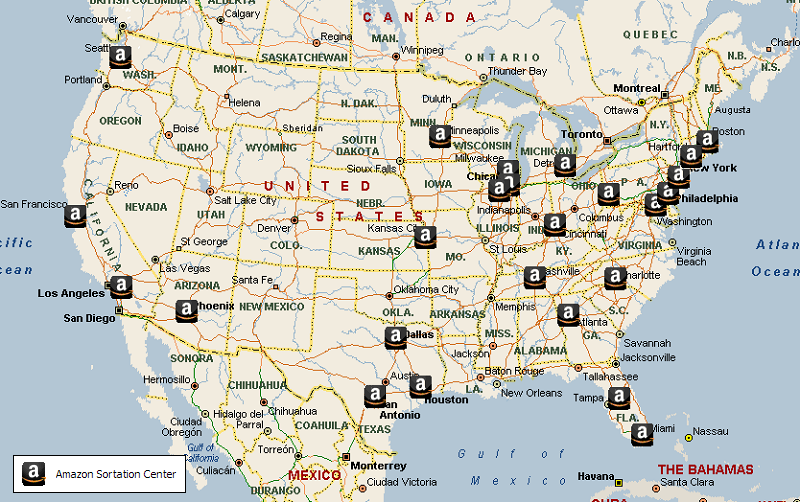|
Supply Chain Digest Blog Entry: July 23, 2014 (here)
If you have been following the Amazon story of late then you have probably heard about the recent buildup of the company's new distribution center network of sortation centers. It has been happening quickly, and as always it has been shrouded in a veil of secrecy. The so-called Amazon experts out there have been predicting a roll-out of forty-plus food distribution facilities nationwide by the end of 2014-2015 but they were completely off the mark. Pardon the pun but there are more important fish to fry right now.
To understand Amazon's distribution network strategy, it is important to understand their supply chain weaknesses which are two-fold:
- Amazon today is primarily an online B2C retailer and as such it has a significant need to build up human resources for the final 2 - 2.5 months of the year. In the United States, Amazon's hiring of temporary associates for peak season in 2013 was reportedly about 70,000 people. In the same year, Target added about 50,000 people despite the fact the two firms were similar in top-line revenue. This illustrates how much more pressure to add human resources is placed on the pure online retailer during peak season as compared to the traditional retailer, and indeed this is a fragility.
- As an aside, there are some people who think that Kiva robots are the panacea to this problem, but robots tend to work best in environments where volumes are consistent. Few companies invest in automation technologies to handle extreme peaks in shipping volume.
- Amazon's most significant weakness has always been, and still remains, its outbound transportation network.
- Most traditional retailers, but not all, control their outbound transportation to the stores. Now some retailers ship primarily using UPS and/or FedEx to replenish their retail stores, but these stores tend to be smaller outlets with tiny back rooms. The larger mass merchants and retailers have established regional distribution centers that ship full truckloads to replenish their stores. Typically there are dedicated carriers or private fleets that can reliably transport freight to market.
- Amazon has never enjoyed this level of control over their outbound transportation function. They rely primarily on national parcel couriers (e.g. UPS, FedEx) to move product to market. The challenge is that these carriers are not dedicated exclusively to Amazon. These carriers have to service all of their customers at peak season and therein lies the problem. When transportation assets are constrained at a national level, and shipments cannot go out on time, then the pain needs to be spread around to all shippers. Amazon is simply another shipper that has to suffer the consequences of transportation infrastructure constraints.
With this background in place, the Amazon sortation network that is currently being constructed becomes easier to understand. First and foremost, it is about taking control over their primary weakness – outbound transportation. Second, and equally importantly, it is about enabling new competitive advantages which pertain to the speed of delivery. The winners are Amazon customers, especially Amazon Prime customers, and the United States Postal Service (for now). The biggest losers are the parcel courier companies who will shortly witness a noticeable drop-off in domestic tonnage.
What is the Amazon Sortation Network?
Amazon is known for building massive distribution centers that store an enormous variety of products. These facilities are typically equipped with high-speed conveyor systems and many hundreds of people focused on moving product out the door as fast as humanly possible. These facilities are known as fulfillment centers and they are designed quite differently from sortation centers. The concept of a sortation center is relatively new to Amazon and to our knowledge it was first introduced by the company in the United Kingdom in mid-2013.
In the United States, a typical fulfillment center might be 1.0 – 1.2 Million square feet in size. The typical sortation center requires a much smaller footprint of between 200 – 300,000 square feet. While a small sortable fulfillment center may require 1,000 – 2,500 full time associates, the sortation center may only need 100 – 300 associates to operate. In general, sortation centers are smaller operations that can be located beside, adjacent to, or nearby larger fulfillment centers.
The primary role of the fulfillment center is to fill customer orders. The primary role of the sortation center is to aggregate shipments from one or more fulfillment centers for delivery into a defined regional grouping of zip codes typically belonging to a nearby set of populated urban areas. In short, sortation centers are designed to bring in and sort out shipments from one or more fulfillment centers whereby the shipments are destined to be delivered a grouping of zip codes within a defined market region around the sortation center. As pallets of sealed shipments arrive, parcels are unloaded onto conveyor belts to be sorted into zip code ranges so that they can be shipped to individual post offices (for now). The output of the process is a set of sorted pallets holding parcels destined to be delivered to specific zip codes. These pallets are then delivered to the United States Postal Service (USPS) post offices (or local courier depots) that can deliver to each of the zip code ranges. The last mile delivery is then performed by USPS or the local courier. In time, Amazon will be in a position to take over more of the last mile delivery function if it suits their purpose to do so.
The primary benefits of this strategy are:
- The ability to deliver on Sundays which is a service that Amazon and USPS announced in November, 2013. The national parcel couriers can provide weekend delivery services but it costs an arm and a leg.
- The sortation center increases the speed to market for shipments and in many cases can shave a day or more off of the order cycle time.
- Sortation centers reportedly reduce shipping costs relative to the former approach of relying on the major parcel couriers to deliver the package. For example, fulfillment centers can now deliver parcels to local customers without the involvement of UPS and FedEx which cuts out the cost of their sortation and delivery cost from the equation.
- Sortation centers are key enablers for the same day delivery or next day delivery promise as they provide a separate infrastructure / platform dedicated to efficiently preparing outbound routes and efficient logistical operations. In effect, they become the consolidation hubs that provide the volume and synergy to construct efficient last mile delivery operations.
- Most importantly, they transfer control of the outbound transportation function away from the national courier companies back to Amazon and this is a very potent competitive advantage. Amazon still requires transportation partners to move goods to market, but make no mistake that they will leverage a much greater sphere of influence in the world of tomorrow under this new arrangement.
Where is the Amazon Sortation Network?
Since late 2013, Amazon has been busy developing their sortation center network. In the United Kingdom, the company has already opened a number of delivery hubs in and around the London Area (Croydon, Bromley-by-Bow, Southall), Manchester, Birmingham, Oxford, Milton Keynes, Nottingham, Leeds and Southampton. These facilities are typically in the 50,000 square feet range and are intended to service highly populated regions of the country that can be reached in short travel distances.
In the United States, Amazon has quietly opened over 20 of sortation centers since September, 2013. This represents a significant investment in real estate and personnel considering that the primary role of these facilities will be to improve transportation efficiency as opposed to fulfilling customer orders.
Looking ahead, we can expect that Amazon will roll out this strategy such that all major fulfillment center ‘clusters’ will be supported by a sortation center to better service regional high population markets. Given that 40 cities make up 40% of the North American population it becomes readily apparent where this is all going.
Take some time to think about this strategy of sortation centers. We see it as a true stroke of genius that makes perfect sense. We think it makes far more sense at this point in Amazon's evolution than investing high amounts of capital with low return on assets into a same day fresh food distribution network across the country. Whoever thought of this sortation center strategy should be congratulated, perhaps even glorified, because it is a truly winning logistical strategy that is based on sanity. For this reason it stands out from all the other chaos and turmoil that is Amazon.
Marc Wulfraat is the President of MWPVL International Inc. He can be reached by clicking here. MWPVL International provides supply chain / logistics network strategy consulting services. Our services include: supply chain network strategy; distribution center design; material handling and automation design; supply chain technology consulting; product sourcing; 3PL Outsourcing; and purchasing; transportation consulting; and operational assessments.

|